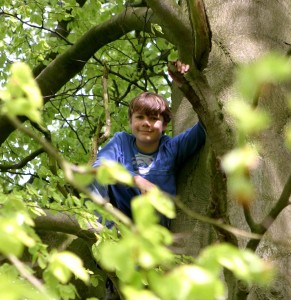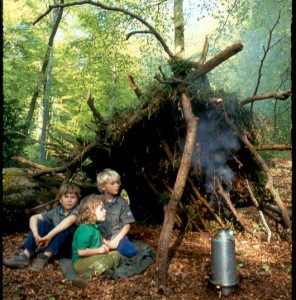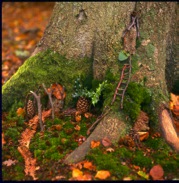Tree Climbing
 A good climbing tree is a real find – a place to test out climbing skills, or somewhere to sit quietly and enjoy the sounds, sights and scents of the natural world. Frequent visits reveal how a tree changes from the bare branches and open views of winter to the full green camouflage of summer, and the golden glow of autumn. Trees may take on personalities of their own; my children used to love visiting the Troll tree – it’s ancient, twisted hollow trunk made a great hidey-hole, but no-one would dare to enter until they had knocked on the bark to scare away the troll who lurked inside! Some friends told us about The One Tree, which stood midway along their favourite walk. It provided a focus for their outings, a place where the children could stop and play among the tangled roots or clamber among the branches. For very young children a tree such as this can become a real friend to return to again and again – they will become familiar with each nook and cranny and have a favourite spot to perch, while older children enjoy the challenge of seeing how high they can climb.
A good climbing tree is a real find – a place to test out climbing skills, or somewhere to sit quietly and enjoy the sounds, sights and scents of the natural world. Frequent visits reveal how a tree changes from the bare branches and open views of winter to the full green camouflage of summer, and the golden glow of autumn. Trees may take on personalities of their own; my children used to love visiting the Troll tree – it’s ancient, twisted hollow trunk made a great hidey-hole, but no-one would dare to enter until they had knocked on the bark to scare away the troll who lurked inside! Some friends told us about The One Tree, which stood midway along their favourite walk. It provided a focus for their outings, a place where the children could stop and play among the tangled roots or clamber among the branches. For very young children a tree such as this can become a real friend to return to again and again – they will become familiar with each nook and cranny and have a favourite spot to perch, while older children enjoy the challenge of seeing how high they can climb.
Den Building
 There is something thrilling for children in making a den – in creating their own special place on their scale, somewhere the grown ups cannot go. Natural dens can be made out in the woods, in the garden or perhaps at a park. The den pictured in Nature’s Playground provided hours of entertainment, from the careful planning, to the collection of logs, sticks and blackberry runners, to the supervised construction. And for weeks afterwards it was the focus for numerous expeditions; this was the children’s space, which they had created deep in the woods, and being in it gave them a great sense of belonging.
There is something thrilling for children in making a den – in creating their own special place on their scale, somewhere the grown ups cannot go. Natural dens can be made out in the woods, in the garden or perhaps at a park. The den pictured in Nature’s Playground provided hours of entertainment, from the careful planning, to the collection of logs, sticks and blackberry runners, to the supervised construction. And for weeks afterwards it was the focus for numerous expeditions; this was the children’s space, which they had created deep in the woods, and being in it gave them a great sense of belonging.
Constructing a den
The den we made used a fallen log along with three long branches from the woodland floor to form the basic structure. Bind them together firmly at the apex with string or stems such as blackberry runners, honeysuckle and wild clematis.
- Secure additional branches along one long side to make a framework, again binding them in place with natural materials found near by.
- Weave smaller twigs and stems through the framework to create a lattice. This must provide a firm mesh suitable for supporting a thatch of leaf litter and grasses.
- Collect leaves and grasses and lay them over the lattice, starting at ground level and working upwards. The thick leaf litter of woodland floors provides an ideal thatching material, which will insulate and keep out the worst of the rain.
- The finer details will depend on the children. They may, for example, wish to sweep the floor to clear a smooth place to sit with their friends, or to build up layers of leaf litter to create a soft bed.
Elf houses
 The natural world is a great stimulus for open-ended imaginative games – children play instinctively with natural materials such as sticks, stones, earth, seeds, shells or whatever else they can find, weaving them into games and creating their own miniature worlds. They might like to make houses for elves or castles for fairies – give them time to play and explore. The little people of the forest may like to live in a dark hole near the base of a tree, with a soft mossy bed and a store of hazelnuts for food. Or they might prefer a hollow in the ground beneath a roof of woven twigs and leaves, with a stone table set with acorn cups and a feast of hawthorn berries arranged on a leaf plate. An elfin knight may need a lookout post, such as a hollow in a tree trunk, accessible only by a tiny ladder and defended with a tough bark door, and an armoury of weapons!
The natural world is a great stimulus for open-ended imaginative games – children play instinctively with natural materials such as sticks, stones, earth, seeds, shells or whatever else they can find, weaving them into games and creating their own miniature worlds. They might like to make houses for elves or castles for fairies – give them time to play and explore. The little people of the forest may like to live in a dark hole near the base of a tree, with a soft mossy bed and a store of hazelnuts for food. Or they might prefer a hollow in the ground beneath a roof of woven twigs and leaves, with a stone table set with acorn cups and a feast of hawthorn berries arranged on a leaf plate. An elfin knight may need a lookout post, such as a hollow in a tree trunk, accessible only by a tiny ladder and defended with a tough bark door, and an armoury of weapons!
Building elf houses is a great outlet for lively minds, both boys and girls enjoy making things for imaginary people in almost any environment. Don’t take anything with you – this activity is all about making the most of whatever is available and working out how different objects might be used.
- Find a good spot for an elf house, whether between tree roots, in a hollow stump, among a pile of stones or in a dip in the ground. The children need to choose their own place, somewhere that captures their imagination and has all the elements they feel are important.
- Search for bracken, twigs, moss, hazelnuts, beech mast, cones, acorns or whatever other suitable items can be found. As the children search and play they will become more familiar with natural materials, perhaps beginning to develop an awareness of the never-ending processes of growth and decay as they find rotting leaves or chewed nuts.
- Allow the children plenty of time to create whatever they want to create, be it a fairy palace or an elf park.
- Choose somewhere you can return to easily. If the elf houses are accessible, but in a place that will not be disturbed, they might provide the start of an on-going game, in which the children build and adapt a castle compound or miniature village.
- Perhaps a corner of the garden could be devoted to versions of the elf-house game. The children might make holiday cottages for the doll’s-house dolls, a fortified castle for a battalion of toy soldiers or stables and barns for plastic farm animals. Here is a chance to extend boundaries by taking an indoor game outdoors, creating many more opportunities for imaginative play than manufactured toys alone can offer.
Tips
Before you go
Encourage the children to wear old clothes and practical footwear.
What to take with you
One of the joys of natural adventures is you never quite know what will happen – so always take along an adventure bag packed with all sorts of things so you are ready for anything! It might include a simple First Aid Kit, a penknife, a magnifying glass and bug box, plastic bags and boxes, string or wool, some old gardening gloves, a plastic bottle of water. Some activities need special equipment – leafy games are much more fun if you take along a couple of rakes and a rug or groundsheet.
Safety tips
1. Tree Climbing
- Children should only climb reasonably mature trees with sturdy branches.
- Do not let children climb on dead branches.
- Limit the number of children climbing any one tree.
- Encourage climbers to stay close to the trunk of a tree.
2. Den Building
- Children should only use knives under adult supervision
- Watch out for plants with thorns and prickles – old gardening gloves provide good protection
3. Elf houses
- Do not let children collect fungi or poisonous berries.
- Make sure they wash their hands thoroughly afterwards
Copyright Fiona Danks and Jo Schofield, July 2006
